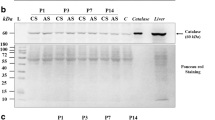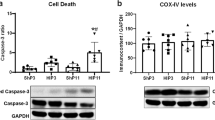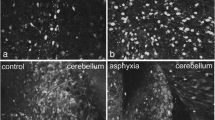Abstract
Perinatal asphyxia remains a significant cause of neonatal mortality and is associated with long-term neurodegenerative disorders. In the present study, we evaluated cellular and subcellular damages to brain development in a model of mild perinatal asphyxia. Survival rate in the experimental group was 67%. One hour after the insult, intraperitoneally injected Evans blue could be detected in the fetuses’ brains, indicating disruption of the blood-brain barrier. Although brain mass and absolute cell numbers (neurons and non-neurons) were not reduced after perinatal asphyxia immediately and in late brain development, subcellular alterations were detected. Cortical oxygen consumption increased immediately after asphyxia, and remained high up to 7 days, returning to normal levels after 14 days. We observed an increased resistance to mitochondrial membrane permeability transition, and calcium buffering capacity in asphyxiated animals from birth to 14 days after the insult. In contrast to ex vivo data, mitochondrial oxygen consumption in primary cell cultures of neurons and astrocytes was not altered after 1% hypoxia. Taken together, our results demonstrate that although newborns were viable and apparently healthy, brain development is subcellularly altered by perinatal asphyxia. Our findings place the neonate brain mitochondria as a potential target for therapeutic protective interventions.






Similar content being viewed by others
References
de Haan M, Wyatt JS, Roth S, Vargha-Khadem F, Gadian D, Mishkin M (2006) Brain and cognitive-behavioural development after asphyxia at term birth. Dev Sci 9:350–358
McGuire W (2006) Perinatal asphyxia. Clin Evid 511–519
Lawn J, Shibuya K, Stein C (2005) No cry at birth: global estimates of intrapartum stillbirths and intrapartum-related neonatal deaths. Bull World Health Organ 83:409–417
Borg E (1997) Perinatal asphyxia, hypoxia, ischemia and hearing loss. An overview. Scand Audiol 26:77–91
Crofts BJ, King R, Johnson A (1998) The contribution of low birth weight to severe vision loss in a geographically defined population. Br J Ophthalmol 82:9–13
Hill A (1991) Current concepts of hypoxic-ischemic cerebral injury in the term newborn. Pediatr Neurol 7:317–325
Cannon M, Jones PB, Murray RM (2002) Obstetric complications and schizophrenia: historical and meta-analytic review. Am J Psychiatry 159:1080–1092
Weitzdoerfer R, Pollak A, Lubec B (2004) Perinatal asphyxia in the rat has lifelong effects on morphology, cognitive functions, and behavior. Semin Perinatol 28:249–256
Wyckoff MH, Aziz K, Escobedo MB, Kapadia VS, Kattwinkel J, Perlman JM, Simon WM, Weiner GM et al (2015) Part 13: neonatal resuscitation: 2015 American Heart Association guidelines update for cardiopulmonary resuscitation and emergency cardiovascular care. Circulation 132:S543–S560
Bjelke B, Andersson K, Ogren SO, Bolme P (1991) Asphyctic lesion: proliferation of tyrosine hydroxylase-immunoreactive nerve cell bodies in the rat substantia nigra and functional changes in dopamine neurotransmission. Brain Res 543:1–9
Morales P, Fiedler JL, Andrés S, Berrios C, Huaiquín P, Bustamante D, Cardenas S, Parra E et al (2008) Plasticity of hippocampus following perinatal asphyxia: effects on postnatal apoptosis and neurogenesis. J Neurosci Res 86:2650–2662
Yenari MA, Han HS (2012) Neuroprotective mechanisms of hypothermia in brain ischaemia. Nat Rev Neurosci 13:267–278. https://doi.org/10.1038/nrn3174
Castillo-Melendez M, Baburamani AA, Cabalag C, Yawno T, Witjaksono A, Miller SL, Walker DW (2013) Experimental modelling of the consequences of brief late gestation asphyxia on newborn lamb behaviour and brain structure. PLoS One 8:e77377
Kaur C, Sivakumar V, Zhang Y, Ling EA (2006) Hypoxia-induced astrocytic reaction and increased vascular permeability in the rat cerebellum. Glia 54:826–839
Chen Y, Hillefors-Berglund M, Herrera-Marschitz M, Bjelke B, Gross J, Andersson K, von Euler G (1997) Perinatal asphyxia induces long-term changes in dopamine D1, D2, and D3 receptor binding in the rat brain. Exp Neurol 146:74–80
Souza SK, Martins TL, Ferreira GD, Vinagre AS, da Silva RSM, Frizzo ME (2013) Metabolic effects of perinatal asphyxia in the rat cerebral cortex. Metab Brain Dis 28:25–32
Reddy NR, Krishnamurthy S, Chourasia TK, Kumar A, Joy KP (2011) Glutamate antagonism fails to reverse mitochondrial dysfunction in late phase of experimental neonatal asphyxia in rats. Neurochem Int 58:582–590
Nunnari J, Suomalainen A (2012) Mitochondria: in sickness and in health. Cell 148:1145–1159
Gilland E, Puka-Sundvall M, Hillered L, Hagberg H (1998) Mitochondrial function and energy metabolism after hypoxia-ischemia in the immature rat brain: involvement of NMDA-receptors. J Cereb Blood Flow Metab 18:297–304
Rosenberg AA, Parks JK, Murdaugh E, Parker WD Jr (1989) Mitochondrial function after asphyxia in newborn lambs. Stroke 20:674–679
Puka-Sundvall M, Gilland E, Hagberg H (2001) Cerebral hypoxia-ischemia in immature rats: involvement of mitochondrial permeability transition? Dev Neurosci 23:192–197
Puka-Sundvall M, Wallin C, Gilland E, Hallin U, Wang X, Sandberg M, Karlsson JO, Blomgren K et al (2000) Impairment of mitochondrial respiration after cerebral hypoxia–ischemia in immature rats: relationship to activation of caspase-3 and neuronal injury. Dev Brain Res 125:43–50
Herculano-Houzel S (2005) Isotropic fractionator: a simple, rapid method for the quantification of total cell and neuron numbers in the brain. J Neurosci 25:2518–2521
Hansen CA, Sidell BD (1983) Atlantic hagfish cardiac muscle: metabolic basis of tolerance to anoxia. Am J Phys 244:R356–R362
Åkerman KEO, Wikström MKF (1976) Safranine as a probe of the mitochondrial membrane potential. FEBS Lett 68:191–197
da Fonseca ACC, Romão L, Amaral RF et al (2012) Microglial stress inducible protein 1 promotes proliferation and migration in human glioblastoma cells. Neuroscience 200:130–141
Lima FRS, Arantes CP, Muras AG, Nomizo R, Brentani RR, Martins VR (2007) Cellular prion protein expression in astrocytes modulates neuronal survival and differentiation. J Neurochem 103:2164–2176
Bandeira F, Lent R, Herculano-Houzel S (2009) Changing numbers of neuronal and non-neuronal cells underlie postnatal brain growth in the rat. Proc Natl Acad Sci U S A 106:14108–14113
Machado V, Pimentel S, Pinto F, Nona J (2015) Perinatal ischemic stroke: a five-year retrospective study in a level-III maternity. Einstein 13:65–71
Frizzo JK, Cardoso MP, de Assis AM, Perry ML, Volonté C, Frizzo ME (2010) Effects of acute perinatal asphyxia in the rat hippocampus. Cell Mol Neurobiol 30:683–692
Morales P, Simola N, Bustamante D, Lisboa F, Fiedler J, Gebicke-Haerter PJ, Morelli M, Tasker RA et al (2010) Nicotinamide prevents the long-term effects of perinatal asphyxia on apoptosis, non-spatial working memory and anxiety in rats. Exp Brain Res 202:1–14
Gidday JM, Gasche YG, Copin J-C, Shah AR, Perez RS, Shapiro SD, Chan PH, Park TS (2005) Leukocyte-derived matrix metalloproteinase-9 mediates blood-brain barrier breakdown and is proinflammatory after transient focal cerebral ischemia. Am J Physiol Heart Circ Physiol 289:H558–H568
Allan SM, Tyrrell PJ, Rothwell NJ (2005) Interleukin-1 and neuronal injury. Nat Rev Immunol 5:629–640
Pan W, Ding Y, Yu Y, Ohtaki H, Nakamachi T, Kastin AJ (2006) Stroke upregulates TNFα transport across the blood–brain barrier. Exp Neurol 198:222–233
Iadecola C, Alexander M (2001) Cerebral ischemia and inflammation. Curr Opin Neurol 14:89–94
Yenari MA, Xu L, Tang XN, Qiao Y, Giffard RG (2006) Microglia potentiate damage to blood-brain barrier constituents: improvement by minocycline in vivo and in vitro. Stroke 37:1087–1093
Simola N, Bustamante D, Pinna A, Pontis S, Morales P, Morelli M, Herrera-Marschitz M (2008) Acute perinatal asphyxia impairs non-spatial memory and alters motor coordination in adult male rats. Exp Brain Res 185:595–601
Shibazaki Y, Nakai A, Koshino T, Yokoyama K (2001) Effect of the immunosuppressant drug FK506 on neonatal cerebral mitochondrial function and energy metabolism after transient intrauterine ischemia in rats. Brain Res 892:351–358
Nioka S, Smith DS, Mayevsky A, Dobson GP, Veech RL, Subramanian H, Chance B (1991) Age dependence of steady state mitochondrial oxidative metabolism in the in vivo hypoxic dog brain. Neurol Res 13:25–32
Kuroda S, Katsura K-I, Tsuchidate R, Siesjo BK (1996) Secondary bioenergetic failure after transient focal ischaemia is due to mitochondrial injury. Acta Physiol Scand 156:149–150
Puka-Sundvall M, Gajkowska B, Cholewinski M, Blomgren K, Lazarewicz JW, Hagberg H (2000) Subcellular distribution of calcium and ultrastructural changes after cerebral hypoxia-ischemia in immature rats. Dev Brain Res 125:31–41
Chouchani ET, Pell VR, Gaude E, Aksentijević D, Sundier SY, Robb EL, Logan A, Nadtochiy SM et al (2014) Ischaemic accumulation of succinate controls reperfusion injury through mitochondrial ROS. Nature 515:431–435
Engidawork E, Loidl F, Chen Y, Kohlhauser C, Stoeckler S, Dell'Anna E, Lubec B, Lubec G et al (2001) Comparison between hypothermia and glutamate antagonism treatments on the immediate outcome of perinatal asphyxia. Exp Brain Res 138:375–383
Lubec B, Mark M, Herrera-Marschitz M et al (1997) Decrease of heart protein kinase C and cyclin- dependent kinase precedes death in perinatal asphyxia of the rat. FASEB J 11:482–492
Lubec B, Dell’Anna E, Fang-Kirchner S et al (1997) Decrease of brain protein kinase C, protein kinase a, and cyclin-dependent kinase correlating with pH precedes neuronal death in neonatal asphyxia of the rat. J Investig Med 45:284–294
Rosafio K, Pellerin L (2013) Oxygen tension controls the expression of the monocarboxylate transporter MCT4 in cultured mouse cortical astrocytes via a hypoxia-inducible factor-1α-mediated transcriptional regulation. Glia 62:477–490
Lages YM, Nascimento JM, Lemos GA, Galina A, Castilho LR, Rehen SK (2015) Low oxygen alters mitochondrial function and response to oxidative stress in human neural progenitor cells. PeerJ 3:e1486
Mnatsakanyan N, Beutner G, Porter GA, Alavian KN, Jonas EA (2017) Physiological roles of the mitochondrial permeability transition pore. J Bioenerg Biomembr 49:13–25
Jonas EA, Buchanan J, Kaczmarek LK (1999) Prolonged activation of mitochondrial conductances during synaptic transmission. Science 286:1347–1350
Giorgio V, von Stockum S, Antoniel M, Fabbro A, Fogolari F, Forte M, Glick GD, Petronilli V et al (2013) Dimers of mitochondrial ATP synthase form the permeability transition pore. Proc Natl Acad Sci U S A 110:5887–5892
Giorgio V, Bisetto E, Soriano ME, Dabbeni-Sala F, Basso E, Petronilli V, Forte MA, Bernardi P et al (2009) Cyclophilin D modulates mitochondrial F0F1-ATP synthase by interacting with the lateral stalk of the complex. J Biol Chem 284:33982–33988
Hom JR, Quintanilla RA, Hoffman DL, de Mesy Bentley KL, Molkentin JD, Sheu SS, Porter GA Jr (2011) The permeability transition pore controls cardiac mitochondrial maturation and myocyte differentiation. Dev Cell 21:469–478
Rocha-Ferreira E, Hristova M (2016) Plasticity in the neonatal brain following hypoxic-ischaemic injury. Neural Plast 2016:4901014
de Vries LS, Groenendaal F (2010) Patterns of neonatal hypoxic–ischaemic brain injury. Neuroradiology 52:555–566
Acknowledgements
This work was supported by Carlos Chagas Filho Research Foundation of the State of Rio de Janeiro (Faperj; grant numbers E-26.102.190/2009, E-26/201.174/2014, E-26/203.024/2015), National Council for Scientific and Technological development (CNPq; grant number 470734/2012-4), and National Institutes for Science and Technology (INCT-NT grant number 465346/2014-6 and INCT-EN grant number 573577/2008-5).
Author information
Authors and Affiliations
Corresponding authors
Ethics declarations
Conflict of Interest
The authors declare that they have no conflict of interest.
Electronic supplementary material
ESM 1
(DOCX 18 kb)
Rights and permissions
About this article
Cite this article
Lima, J.P.M., Rayêe, D., Silva-Rodrigues, T. et al. Perinatal Asphyxia and Brain Development: Mitochondrial Damage Without Anatomical or Cellular Losses. Mol Neurobiol 55, 8668–8679 (2018). https://doi.org/10.1007/s12035-018-1019-7
Received:
Accepted:
Published:
Issue Date:
DOI: https://doi.org/10.1007/s12035-018-1019-7




